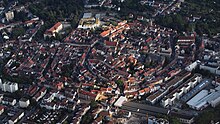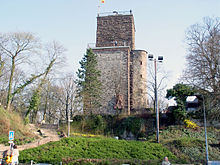
Baden-Baden is a spa town in the state of Baden-Württemberg, south-western Germany, at the north-western border of the Black Forest mountain range on the small river Oos, ten kilometres east of the Rhine, the border with France, and forty kilometres north-east of Strasbourg, France.
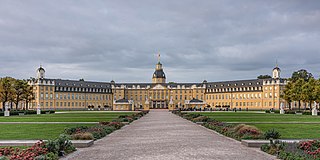
Karlsruhe is the third-largest city of the German state of Baden-Württemberg, after its capital Stuttgart and Mannheim, and the 22nd-largest city in the nation, with 308,436 inhabitants. It is also a former capital of Baden, a historic region named after Hohenbaden Castle in the city of Baden-Baden. Located on the right bank of the Rhine near the French border, between the Mannheim-Ludwigshafen conurbation to the north and Strasbourg to the south, Karlsruhe is Germany's legal center, being home to the Federal Constitutional Court, the Federal Court of Justice and the Public Prosecutor General.
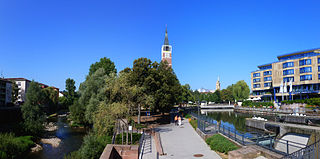
Pforzheim is a city of over 125,000 inhabitants in the federal state of Baden-Württemberg, in the southwest of Germany.

Ettlingen is a town in Baden-Württemberg, Germany, about 8 kilometres (5 mi) south of the city of Karlsruhe and approximately 15 kilometres (9 mi) from the border with Lauterbourg, in France's Bas-Rhin department. Ettlingen is the second largest town in the district of Karlsruhe, after Bruchsal.
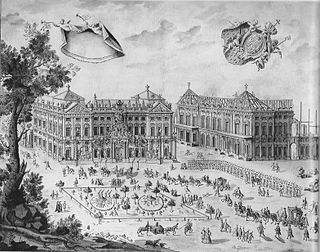
Residenz is a German word for "domicile", now obsolete except in the formal sense of an official residence. A related term, Residenzstadt, denotes a city where a sovereign ruler resided, and thus carries a similar meaning to the contemporary expressions seat of government or capital. As there were many sovereign rulers in the Holy Roman Empire, ranking from lord (Herr) to prince elector and king, there are many cities, palaces, and castles in the empire's former territory which used to be a Residenz, some of which are still so referred to today. The former status of a city as a Residenz is frequently reflected in the architecture of its center. During the baroque period especially, many prestigious buildings were erected; sometimes even new towns were founded. Most former Residenzstädte still serve as cultural and administrative centers today.

The Margraviate of Baden was a historical territory of the Holy Roman Empire. Spread along the right banks of the Upper Rhine in south-western Germany, it was named a margraviate in 1112 and existed until 1535, when it was split into the two margraviates of Baden-Durlach and Baden-Baden. The two parts were reunited in 1771 under Margrave Charles Frederick, even if the three parts of the state maintained their distinct seats to the Reichstag. The restored Margraviate of Baden was elevated to the status of electorate in 1803. In 1806, the Electorate of Baden, receiving territorial additions, became the Grand Duchy of Baden. The rulers of Baden, known as the House of Baden, were a line of the Swabian House of Zähringen.
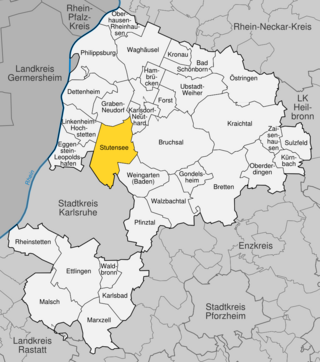
Stutensee is a town in northern Karlsruhe district in Baden-Württemberg, Germany.

Charles II, Margrave of Baden-Durlach, nicknamed Charles with the bag, governed the Margravate of Baden-Durlach from 1552 to 1577. On 1 June 1556 Charles issued a new Church Order, which made Lutheranism the official religion in Baden-Durlach.
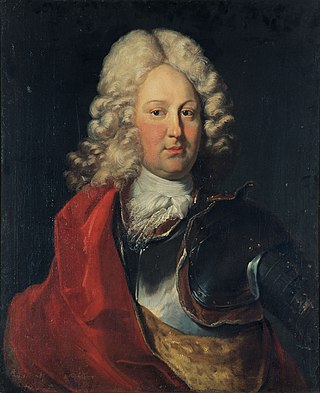
Charles III William was Margrave of Baden-Durlach between 1709 and 1738. He was the son of Margrave Frederick Magnus of Baden-Durlach and Augusta Maria of Schleswig-Holstein-Gottorp. In 1715, he established Karlsruhe, where he built his residence. Karlsruhe has since grown to a large city. With the consolidation of public finances and the creation of a reliable administration, he laid the foundations for the reform policies of his grandson, Charles Frederick.
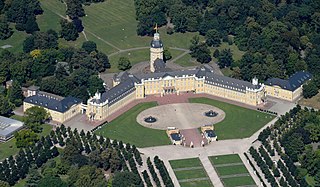
Karlsruhe Palace was built in 1715 for Margrave Charles III William of Baden-Durlach after a dispute with the citizens of his previous capital, Durlach. The city of Karlsruhe has since grown around it. The building is now home to the main museum of the Badisches Landesmuseum.

Edward Fortunatus of Baden was Margrave of Baden-Rodemachern and Baden-Baden.

The Baden main line is a German railway line that was built between 1840 and 1863. It runs through Baden, from Mannheim via Heidelberg, Karlsruhe, Offenburg, Freiburg, Basel, Waldshut, Schaffhausen and Singen to Konstanz. The Baden Mainline is 412.7 kilometres long, making it the longest route in the Deutsche Bahn network and also the oldest in southwest Germany. The section between Mannheim and Basel is the most important northern approach to the Swiss Alpine passes, whilst the section between Basel and Konstanz is only of regional significance. The stretch from Karlsruhe to Basel is also known as the Rhine Valley Railway (Rheintalbahn) and the Basel–Konstanz section as the High Rhine Railway (Hochrheinstrecke).

The Margraviate of Baden-Durlach was an early modern territory of the Holy Roman Empire, in the upper Rhine valley, which existed from 1535 to 1771. It was formed when the Margraviate of Baden was split between the sons of Margrave Christopher I and was named for its capital, Durlach. The other half of the territory became the Margraviate of Baden-Baden, located between the two halves of Baden-Durlach. Baden-Durlach became Lutheran during the Protestant Reformation, unlike Baden-Baden, which remained Catholic. Baden-Durlach occupied Baden-Baden from 1594 to 1622, but was driven out after being defeated at the Battle of Wimpfen, during the Thirty Years' War (1618–1648). The territory was ravaged during the Nine Years' War (1688–1697). Following the extinction of the Baden-Baden line in 1771, the Baden-Durlach inherited their territories and reunited the Margraviate of Baden. The reunified territory was caught up in the French Revolutionary and Napoleonic Wars, emerging in 1806 as the Grand Duchy of Baden.
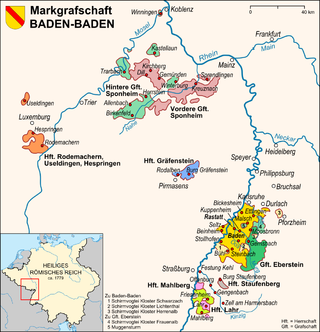
The Margraviate of Baden-Baden was an early modern southwest German territory within the Holy Roman Empire. It was created in 1535 along with the Margraviate of Baden-Durlach as a result of the division of the Margraviate of Baden. Its territory consisted of a core area on the middle stretch of the Upper Rhine around the capital city of Baden, as well as lordships on the Moselle and Nahe.

Karlsburg Castle in the Durlach district of Karlsruhe characterizes the history of the Baden since 1563. Only the Prinzessinnenbau of the historical building still stands.
Bad Rotenfels is a district in the city of Gaggenau, district of Rastatt, in Baden-Württemberg, Germany. It is located some 8 km northeast of Baden-Baden.
Ursula of Rosenfeld was the second wife of Margrave Ernest of Baden-Durlach. All grand dukes of Baden descend from her, via her son Charles II.

Baden is a historical territory in southern Germany. In earlier times it was considered to be on both sides of the Upper Rhine, but since the Napoleonic Wars, it has been considered only East of the Rhine.

The Yburg is a ruined hilltop castle atop the Yberg, on the western edge of the Black Forest near Baden-Baden, in southwestern Germany.

Neureut is the northernmost district of Karlsruhe, Germany. It was the most populous rural community of Baden-Württemberg before being incorporated into Karlsruhe on February 14, 1975. Its population is about 18,920 people as of December 31, 2020.
